Effect of Salinity on the Gut Microbiome of Pike Fry (Esox lucius)
Abstract
1. Introduction
2. Materials and Methods
2.1. Conditions of Fish Rearing
2.2. Sampling
2.3. DNA Extraction
2.4. 16S rRNA Gene Amplicon Library Preparation and Sequencing
2.5. Microbiome Analysis
2.6. Statistical Analysis
3. Results
3.1. Fish Culturing
3.2. Qiime Analysis of Sequencing Data
3.3. Characterization of the Pike Gut Microbiome
4. Discussion
5. Conclusions
Supplementary Materials
Author Contributions
Funding
Conflicts of Interest
References
- Forsman, A.; Tibblin, P.; Berggren, H.; Nordahl, O.; Koch-Schmidt, P.; Larsson, P. Pike Esox lucius as an emerging model organism for studies in ecology and evolutionary biology: A review: Esox lucius as a model in ecology and evolution. J. Fish Biol. 2015, 87, 472–479. [Google Scholar] [CrossRef] [PubMed]
- Craig, J.F. Pike: Biology and Exploitation; Springer: Dordrecht, The Netherlands, 1996; ISBN 978-94-015-8775-4. [Google Scholar]
- Pierce, R.B.; Tomcko, C.M.; Schupp, D.H. Exploitation of Northern Pike in Seven Small North-Central Minnesota Lakes. N. Am. J. Fish. Manag. 1995, 15, 601–609. [Google Scholar] [CrossRef]
- Arlinghaus, R.; Mehner, T. A Management-Orientated Comparative Analysis of Urban and Rural Anglers Living in a Metropolis (Berlin, Germany). Environ. Manag. 2004, 33, 331–344. [Google Scholar] [CrossRef] [PubMed]
- Lehtonen, H.; Leskinen, E.; SeléN, R.; Reinikainen, M. Potential reasons for the changes in the abundance of pike, Esox lucius, in the western Gulf of Finland, 1939–2007: Changes in pike abundance in the gulf of finland. Fish. Manag. Ecol. 2009, 16, 484–491. [Google Scholar] [CrossRef]
- Balik, Ü.; Cubuk, H.; Özkök, R.; Uysal, R. Reproduction Properties of Pike (Esox lucius L., 1758) Population in Lake KaramÝk (Afyonkarahisar/Turkey). Fish. Res. Inst. 2006, 30, 27–34. [Google Scholar]
- Muscalu-Nagy, C.; Muscalu-Nagy, R.; Balázs, K. Attempts to increase the growth rhythm of juvenile Northern pike (Esox lucius, L.) by adding enzyme based ingredients into dry feed. Aquac. Aquar. Conserv. Legis. 2013, 6, 99–104. [Google Scholar]
- Suguna, P.; Binuramesh, C.; Abirami, P.; Saranya, V.; Poornima, K.; Rajeswari, V.; Shenbagarathai, R. Immunostimulation by poly-β hydroxybutyrate–hydroxyvalerate (PHB–HV) from Bacillus thuringiensis in Oreochromis mossambicus. Fish Shellfish Immunol. 2014, 36, 90–97. [Google Scholar] [CrossRef]
- Magondu, E.W.; Rasowo, J.; Oyoo-Okoth, E.; Charo-Karisa, H. Evaluation of sodium chloride (NaCl) for potential prophylactic treatment and its short-term toxicity to African catfish Clarias gariepinus (Burchell 1822) yolk-sac and swim-up fry. Aquaculture 2011, 319, 307–310. [Google Scholar] [CrossRef]
- Noga, E.J. Fish Disease: Diagnosis and Treatment, 2nd ed.; Iowa State University Press: Ames, IA, USA, 2000. [Google Scholar]
- Schnick, R.A. The Impetus to Register New Therapeutants for Aquaculture. Progress. Fish Cult. 1988, 50, 190–196. [Google Scholar] [CrossRef]
- Selosse, P.M.; Rowland, S.J. Use of Common Salt to Treat Ichthyophthiriasis in Australian Warmwater Fishes. Progress. Fish Cult. 1990, 52, 124–127. [Google Scholar] [CrossRef]
- Garcia Magana, L.; Jimenez Vasconcelos, L.; Rodriguez Santiago, A.; Grano Maldonado, M.; Laffon Leal, S. The effectiveness of sodium chloride and formalin in trichodiniasis of farmed freshwater tilapia Oreochromis niloticus (Linnaeus, 1758) in southeastern Mexico. Lat. Am. J. Aquat. Res. 2019, 47, 164–174. [Google Scholar] [CrossRef]
- Lisboa, V.; Barcarolli, I.F.; Sampaio, L.A.; Bianchini, A. Effect of salinity on survival, growth and biochemical parameters in juvenile Lebranch mullet Mugil liza (Perciformes: Mugilidae). Neotrop. Ichthyol. 2015, 13, 447–452. [Google Scholar] [CrossRef]
- Zhang, M.; Sun, Y.; Liu, Y.; Qiao, F.; Chen, L.; Liu, W.-T.; Du, Z.; Li, E. Response of gut microbiota to salinity change in two euryhaline aquatic animals with reverse salinity preference. Aquaculture 2016, 454, 72–80. [Google Scholar] [CrossRef]
- Edwards, S.L.; Marshall, W.S. Principles and patterns of osmoregulation and euryhalinity in fishes. In Euryhaline Fishes, 1st ed.; McCormick, S.D., Farrell, A.P., Brauner, C.J., Eds.; Academic: Oxford, UK, 2013; Volume 32, pp. 1–44. [Google Scholar]
- Engström-Öst, J.; Lehtiniemi, M.; Jónasdóttir, S.H.; Viitasalo, M. Growth of pike larvae (Esox lucius) under different conditions of food quality and salinity. Ecol. Freshw. Fish 2005, 14, 385–393. [Google Scholar] [CrossRef]
- Jacobsen, L.; Skov, C.; Koed, A.; Berg, S. Short-term salinity tolerance of northern pike, Esox lucius, fry, related to temperature and size. Fish. Manag. Ecol. 2007, 14, 303–308. [Google Scholar] [CrossRef]
- Sunde, J.; Tamario, C.; Tibblin, P.; Larsson, P.; Forsman, A. Variation in salinity tolerance between and within anadromous subpopulations of pike (Esox lucius). Sci. Rep. 2018, 8, 1–11. [Google Scholar] [CrossRef]
- Crossman, E.J. Taxonomy and distribution of North American esocids. Am. Fish. Soc. 1978, 11, 13–26. [Google Scholar]
- Mohrholz, V.; Naumann, M.; Nausch, G.; Krüger, S.; Gräwe, U. Fresh oxygen for the Baltic Sea—An exceptional saline inflow after adecade of stagnation. J. Mar. Syst. 2015, 148, 152–166. [Google Scholar] [CrossRef]
- Abou Anni, I.S.; Bianchini, A.; Barcarolli, I.F.; Varela, A.S.; Robaldo, R.B.; Tesser, M.B.; Sampaio, L.A. Salinity influence on growth, osmoregulation and energy turnover in juvenile pompano Trachinotus marginatus Cuvier 1832. Aquaculture 2016, 455, 63–72. [Google Scholar] [CrossRef]
- Árnason, T.; Magnadóttir, B.; Björnsson, B.; Steinarsson, A.; Björnsson, B.T. Effects of salinity and temperature on growth, plasma ions, cortisol and immune parameters of juvenile Atlantic cod (Gadus morhua). Aquaculture 2013, 380, 70–79. [Google Scholar] [CrossRef]
- Urbina, M.A.; Glover, C.N. Effect of salinity on osmoregulation, metabolism and nitrogen excretion in the amphidromous fish, inanga (Galaxias maculatus). J. Exp. Mar. Biol. Ecol. 2015, 473, 7–15. [Google Scholar] [CrossRef]
- Brugman, S.; Nieuwenhuis, E.E.S. Mucosal control of the intestinal microbial community. J. Mol. Med. 2010, 88, 881–888. [Google Scholar] [CrossRef] [PubMed]
- Viney, M.E.; Riley, E.M. From immunology to eco-immunology: More than a new name. In Eco-Immunology, 1st ed.; Mala-goli, D., Ottaviani, E., Eds.; Springer: Dordrecht, Holland, 2014; pp. 1–19. [Google Scholar]
- Wang, A.R.; Ran, C.; Ringø, E.; Zhou, Z.G. Progress in fish gastrointestinal microbiota research. Rev. Aquac. 2018, 10, 626–640. [Google Scholar] [CrossRef]
- Ghanbari, M.; Kneifel, W.; Domig, K.J. A new view of the fish gut microbiome: Advances from next-generation sequencing. Aquaculture 2015, 448, 464–475. [Google Scholar] [CrossRef]
- Eichmiller, J.J.; Hamilton, M.J.; Staley, C.; Sadowsky, M.J.; Sorensen, P.W. Environment shapes the fecal microbiome of invasive carp species. Microbiome 2016, 4, 44. [Google Scholar] [CrossRef] [PubMed]
- Hennersdorf, P.; Kleinertz, S.; Theisen, S.; Abdul-Aziz, M.A.; Mrotzek, G.; Palm, H.W.; Saluz, H.P. Microbial Diversity and Parasitic Load in Tropical Fish of Different Environmental Conditions. PLoS ONE 2016, 11, e0151594. [Google Scholar] [CrossRef]
- Kashinskaya, E.N.; Simonov, E.P.; Kabilov, M.R.; Izvekova, G.I.; Andree, K.B.; Solovyev, M.M. Diet and other environmental factors shape the bacterial communities of fish gut in an eutrophic lake. J. Appl. Microbiol. 2018, 125, 1626–1641. [Google Scholar] [CrossRef]
- Schmidt, V.T.; Smith, K.F.; Melvin, D.W.; Amaral-Zettler, L.A. Community assembly of a euryhaline fish microbiome during salinity acclimation. Mol. Ecol. 2015, 24, 2537–2550. [Google Scholar] [CrossRef]
- Sullam, K.E.; Essinger, S.D.; Lozupone, C.A.; O’Connor, M.P.; Rosen, G.L.; Knight, R.; Kilham, S.S.; Russell, J.A. Environmental and ecological factors that shape the gut bacterial communities of fish: A meta-analysis. Mol. Ecol. 2012, 21, 3363–3378. [Google Scholar] [CrossRef]
- Roeselers, G.; Mittge, E.K.; Stephens, W.Z.; Parichy, D.M.; Cavanaugh, C.M.; Guillemin, K.; Rawls, J.F. Evidence for a core gut microbiota in the zebrafish. ISME J. 2011, 5, 1595–1608. [Google Scholar] [CrossRef]
- Dulski, T.; Zakęś, Z.; Ciesielski, S. Characterization of the gut microbiota in early life stages of pikeperch Sander lucioperca: Gut microbiota of S. lucioperca. J. Fish Biol. 2018, 92, 94–104. [Google Scholar] [CrossRef] [PubMed]
- Komoroske, L.M.; Jeffries, K.M.; Connon, R.E.; Dexter, J.; Hasenbein, M.; Verhille, C.; Fangue, N.A. Sublethal salinity stress contributes to habitat limitation in an endangered estuarine fish. Evol. Appl. 2016, 9, 963–981. [Google Scholar] [CrossRef] [PubMed]
- Nossa, C.W. Design of 16S rRNA gene primers for 454 pyrosequencing of the human foregut microbiome. World J. Gastroenterol. 2010, 16, 4135. [Google Scholar] [CrossRef] [PubMed]
- Klindworth, A.; Pruesse, E.; Schweer, T.; Peplies, J.; Quast, C.; Horn, M.; Glöckner, F.O. Evaluation of general 16S ribosomal RNA gene PCR primers for classical and next-generation sequencing-based diversity studies. Nucleic Acids Res. 2013, 41, e1. [Google Scholar] [CrossRef] [PubMed]
- Caporaso, J.G.; Kuczynski, J.; Stombaugh, J.; Bittinger, K.; Bushman, F.D.; Costello, E.K.; Fierer, N.; Peña, A.G.; Goodrich, J.K.; Gordon, J.I.; et al. QIIME allows analysis of high-throughput community sequencing data. Nat. Methods 2010, 7, 335–336. [Google Scholar] [CrossRef] [PubMed]
- Amir, A.; McDonald, D.; Navas-Molina, J.A.; Kopylova, E.; Morton, J.T.; Zech Xu, Z.; Kightley, E.P.; Thompson, L.R.; Hyde, E.R.; Gonzalez, A.; et al. Deblur Rapidly Resolves Single-Nucleotide Community Sequence Patterns. MSystems 2017, 2. [Google Scholar] [CrossRef] [PubMed]
- Parks, D.H.; Beiko, R.G. Identifying biologically relevant differences between metagenomic communities. Bioinformatics 2010, 26, 715–721. [Google Scholar] [CrossRef]
- Benjamini, Y.; Hochberg, Y. Controlling the false discovery rate: A practical and powerful approach to multiple testing. J. R. Stat. Soc. 1995, 57, 289–300. [Google Scholar] [CrossRef]
- Lozupone, C.; Knight, R. UniFrac: A New Phylogenetic Method for Comparing Microbial Communities. Appl. Environ. Microbiol. 2005, 71, 8228–8235. [Google Scholar] [CrossRef]
- Lozupone, C.A.; Hamady, M.; Kelley, S.T.; Knight, R. Quantitative and Qualitative Diversity Measures Lead to Different Insights into Factors That Structure Microbial Communities. Appl. Environ. Microbiol. 2007, 73, 1576–1585. [Google Scholar] [CrossRef]
- Kang’ombe, J.; Brown, J.A. Effect of Salinity on Growth, Feed Utilization, and Survival of Tilapia rendalli Under Laboratory Conditions. J. Appl. Aquac. 2008, 20, 256–271. [Google Scholar] [CrossRef]
- Dokuboba, A.; Akinrotimi, O.A.; Dabor, P.O. Effects of Different Physiological Saline Concentrations on the Reproductive Performance of Clarias gariepinus (Burchell, 1822). J. Fish. Sci. 2018, 12, 004–008. [Google Scholar]
- Su, B.; Perera, D.A.; Mu, X.; Dunham, R.A. Effect of Sodium Chloride on Hatching Rate on Channel Catfish, Ictalurus punctatus, Embryos. J. Appl. Aquac. 2013, 25, 283–292. [Google Scholar] [CrossRef]
- Dehler, C.E.; Secombes, C.J.; Martin, S.A.M. Seawater transfer alters the intestinal microbiota profiles of Atlantic salmon (Salmo salar L.). Sci. Rep. 2017, 7, 1–11. [Google Scholar] [CrossRef]
- Dewi, R.R. The Efficacy of Sodium Chloride Application in the Control of Fish Lice (Argulus sp.) infection on Tilapia (Oreochromis niloticus). Acta Aquat. Aquat. Sci. J. 2018, 5, 4–7. [Google Scholar] [CrossRef]
- Tacchi, L.; Lowrey, L.; Musharrafieh, R.; Crossey, K.; Larragoite, E.T.; Salinas, I. Effects of transportation stress and addition of salt to transport water on the skin mucosal homeostasis of rainbow trout (Oncorhynchus mykiss). Aquaculture 2015, 435, 120–127. [Google Scholar] [CrossRef]
- Romero, J.; Ringø, E.; Merrifield, D.L. The Gut Microbiota of Fish in Aquaculture Nutrition. In Aquaculture Nutrition: Gut Health, Probiotics and Prebiotics, 2nd ed.; Merrifield, D., Ringø, E., Eds.; Wiley-Blackwell Publishing: Oxford, UK, 2014; pp. 75–100. [Google Scholar]
- Navarrete, P.; Magne, F.; Araneda, C.; Fuentes, P.; Barros, L.; Opazo, R.; Espejo, R.; Romero, J. PCR-TTGE Analysis of 16S rRNA from Rainbow Trout (Oncorhynchus mykiss) Gut Microbiota Reveals Host-Specific Communities of Active Bacteria. PLoS ONE 2012, 7, e31335. [Google Scholar] [CrossRef]
- Li, J.; Ni, J.; Li, J.; Wang, C.; Li, X.; Wu, S.; Zhang, T.; Yu, Y.; Yan, Q. Comparative study on gastrointestinal microbiota of eight fish species with different feeding habits. J. Appl. Microbiol. 2014, 117, 1750–1760. [Google Scholar] [CrossRef]
- Liu, H.; Guo, X.; Gooneratne, R.; Lai, R.; Zeng, C.; Zhan, F.; Wang, W. The gut microbiome and degradation enzyme activity of wild freshwater fishes influenced by their trophic levels. Sci. Rep. 2016, 6, 24340. [Google Scholar] [CrossRef]
- Givens, C.; Ransom, B.; Bano, N.; Hollibaugh, J. Comparison of the gut microbiomes of 12 bony fish and 3 shark species. Mar. Ecol. Prog. Ser. 2015, 518, 209–223. [Google Scholar] [CrossRef]
- Llewellyn, M.S.; Boutin, S.; Hoseinifar, S.H.; Derome, N. Teleost microbiomes: The state of the art in their characterization, manipulation and importance in aquaculture and fisheries. Front. Microbiol. 2014, 5, 207. [Google Scholar] [CrossRef] [PubMed]
- Xia, J.H.; Lin, G.; Fu, G.H.; Wan, Z.Y.; Lee, M.; Wang, L.; Liu, X.J.; Yue, G.H. The intestinal microbiome of fish under starvation. BMC Genom. 2014, 15, 266. [Google Scholar] [CrossRef] [PubMed]
- Sevellec, M.; Pavey, S.A.; Boutin, S.; Filteau, M.; Derome, N.; Bernatchez, L. Microbiome investigation in the ecological speciation context of lake whitefish (Coregonus clupeaformis) using next-generation sequencing. J. Evol. Biol. 2014, 27, 1029–1046. [Google Scholar] [CrossRef] [PubMed]
- Star, B.; Haverkamp, T.H.A.; Jentoft, S.; Jakobsen, K.S. Next generation sequencing shows high variation of the intestinal microbial species composition in Atlantic cod caught at a single location. BMC Microbiol. 2013, 13, 248. [Google Scholar] [CrossRef]
- Ramírez, C.; Romero, J. Fine Flounder (Paralichthys adspersus) Microbiome Showed Important Differences between Wild and Reared Specimens. Front. Microbiol. 2017, 8, 271. [Google Scholar] [CrossRef]
- Geraylou, Z.; Souffreau, C.; Rurangwa, E.; Maes, G.E.; Spanier, K.I.; Courtin, C.M.; Delcour, J.A.; Buyse, J.; Ollevier, F. Prebiotic effects of arabinoxylan oligosaccharides on juvenile Siberian sturgeon (Acipenser baerii) with emphasis on the modulation of the gut microbiota using 454 pyrosequencing. FEMS Microbiol. Ecol. 2013, 86, 357–371. [Google Scholar] [CrossRef]
- Wu, S.; Wang, G.; Angert, E.R.; Wang, W.; Li, W.; Zou, H. Composition, Diversity, and Origin of the Bacterial Community in Grass Carp Intestine. PLoS ONE 2012, 7, e30440. [Google Scholar] [CrossRef]
- Schmidt, V.; Amaral-Zettler, L.; Davidson, J.; Summerfelt, S.; Good, C. Influence of Fishmeal-Free Diets on Microbial Communities in Atlantic Salmon (Salmo salar) Recirculation Aquaculture Systems. Appl. Environ. Microbiol. 2016, 82, 4470–4481. [Google Scholar] [CrossRef]
- Egerton, S.; Culloty, S.; Whooley, J.; Stanton, C.; Ross, R.P. The Gut Microbiota of Marine Fish. Front. Microbiol. 2018, 9, 873. [Google Scholar] [CrossRef]
- Ringø, E.; Birkbeck, T.H. Intestinal microflora of fish larvae and fry. Aquac. Res. 1999, 30, 73–93. [Google Scholar] [CrossRef]
- McIntosh, D.; Ji, B.; Forward, B.S.; Puvanendran, V.; Boyce, D.; Ritchie, R. Culture-independent characterization of the bacterial populations associated with cod (Gadus morhua L.) and live feed at an experimental hatchery facility using denaturing gradient gel electrophoresis. Aquaculture 2008, 275, 42–50. [Google Scholar] [CrossRef]
- Zhou, Z.; Yao, B.; Romero, J.; Waines, P.; Ringø, E.; Emery, M.; Liles, M.; Merrifield, D.L. Methodological approaches used to assess fishgastrointestinal communities. In Aquaculture Nutrition: Gut Health, Probiotics and Prebiotics, 2nd ed.; Merrifield, D., Ringø, E., Eds.; Wiley-Blackwell Publishing: Oxford, UK, 2014; pp. 101–127. [Google Scholar]
- Lage, O.M.; Bondoso, J. Planctomycetes and macroalgae, a striking association. Front. Microbiol. 2014, 5, 267. [Google Scholar] [CrossRef] [PubMed]
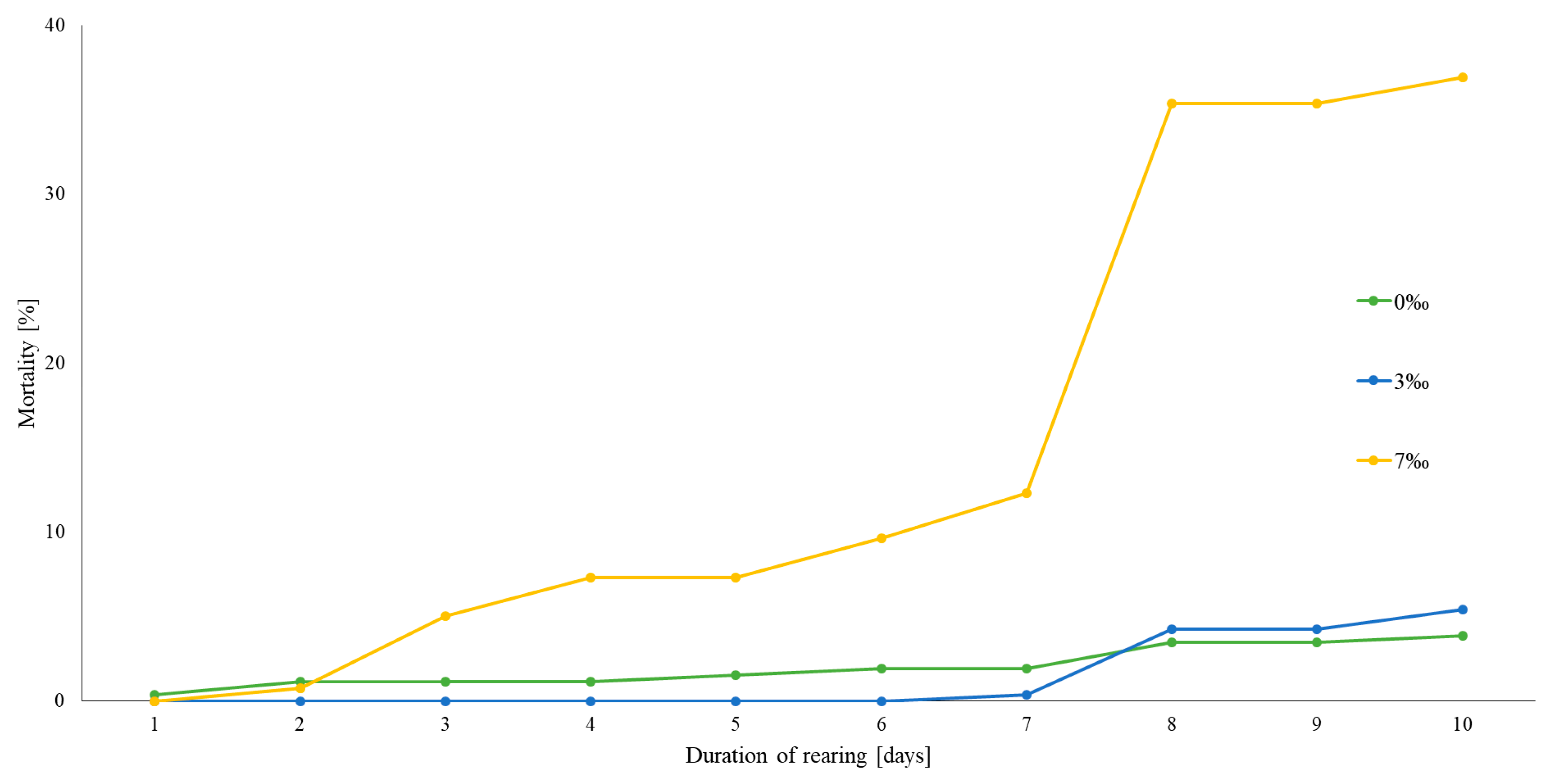
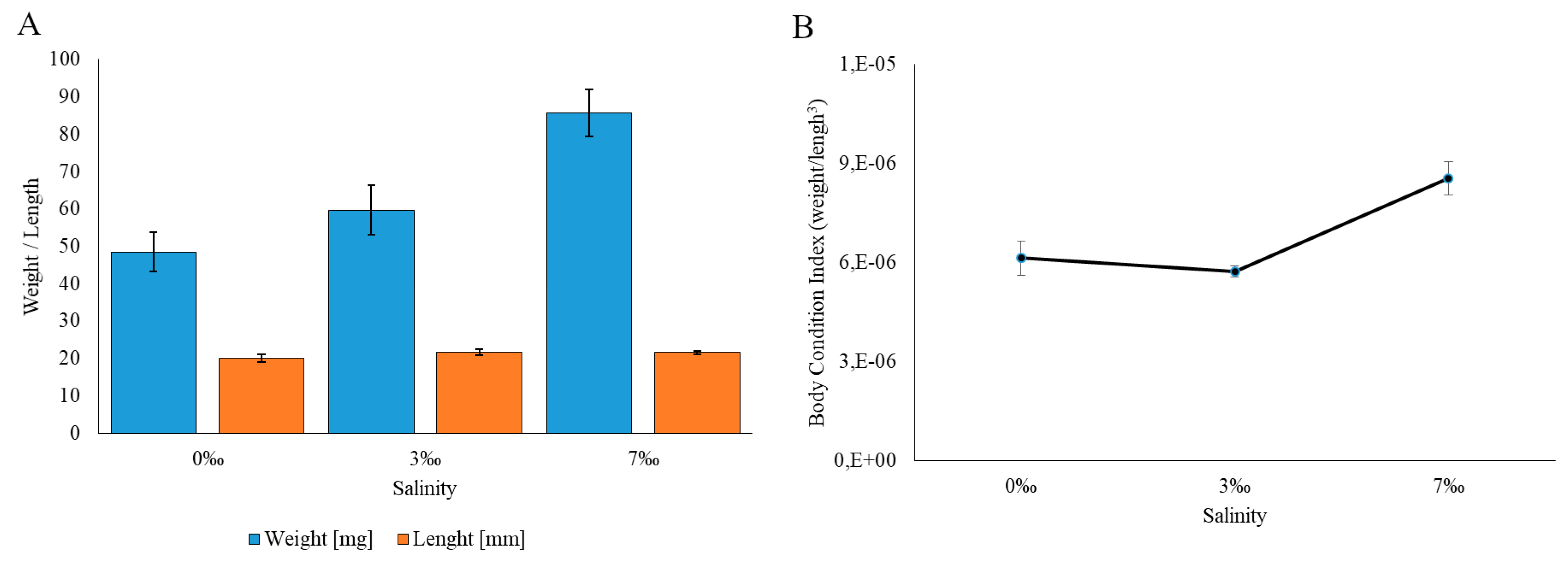
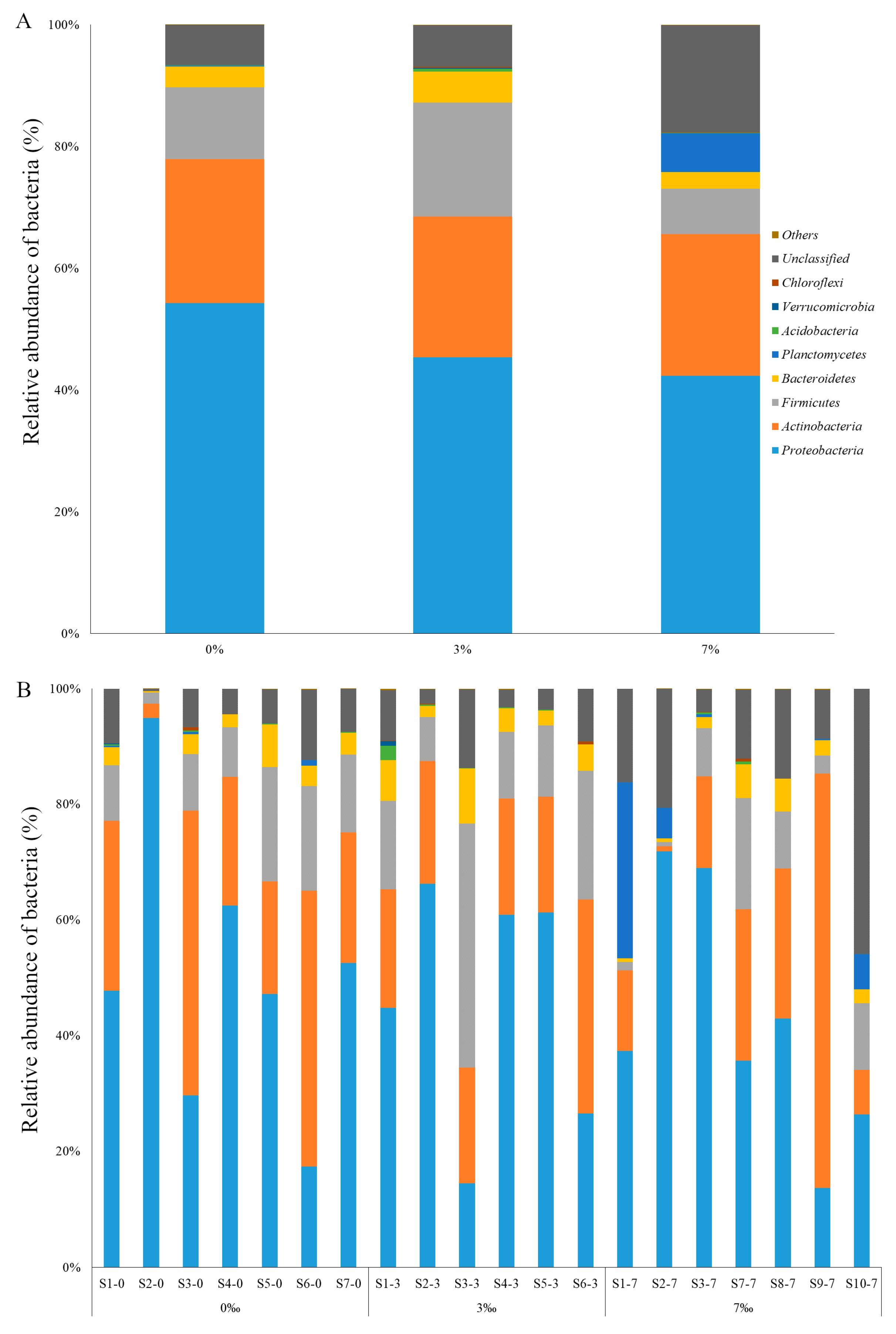
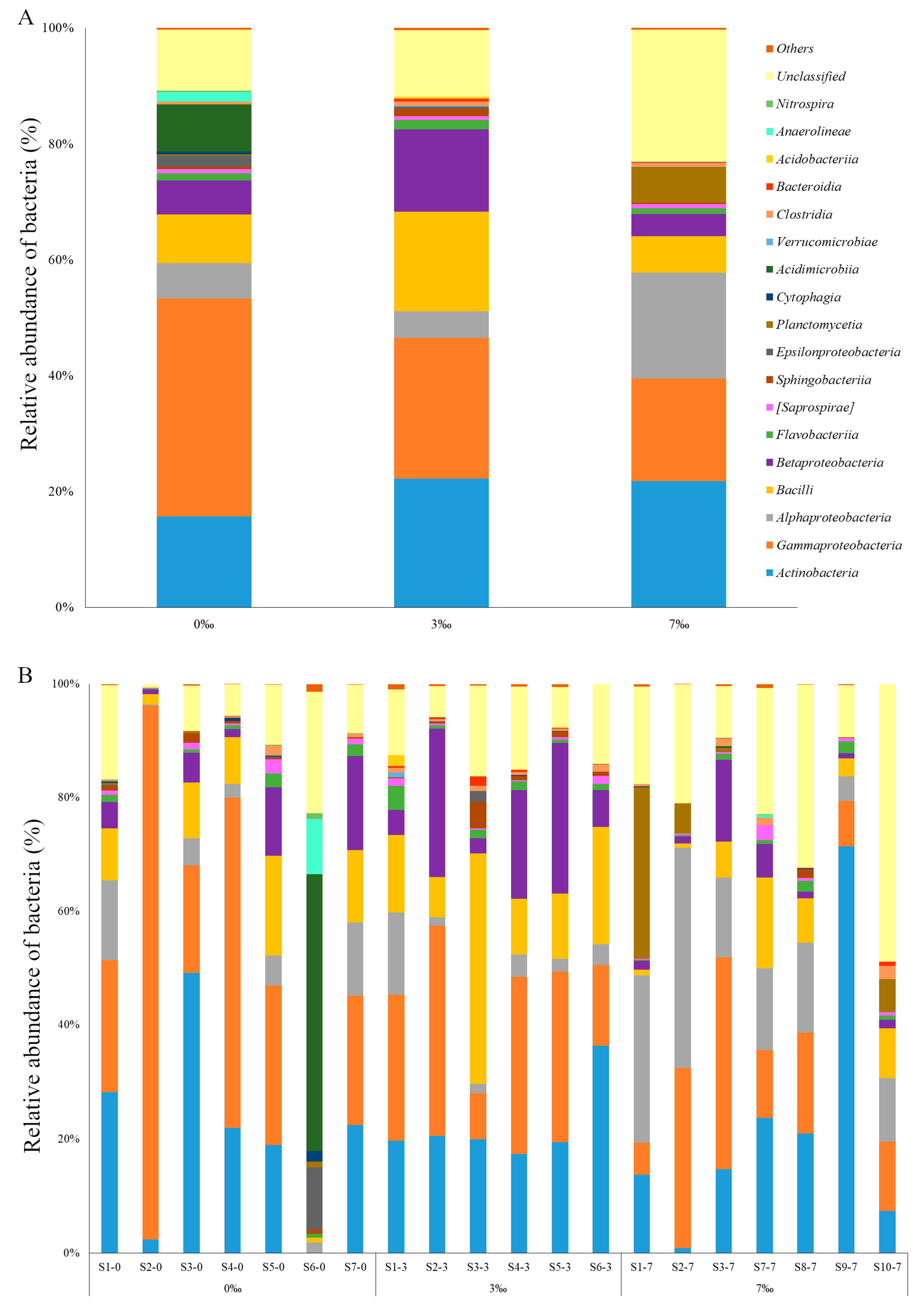
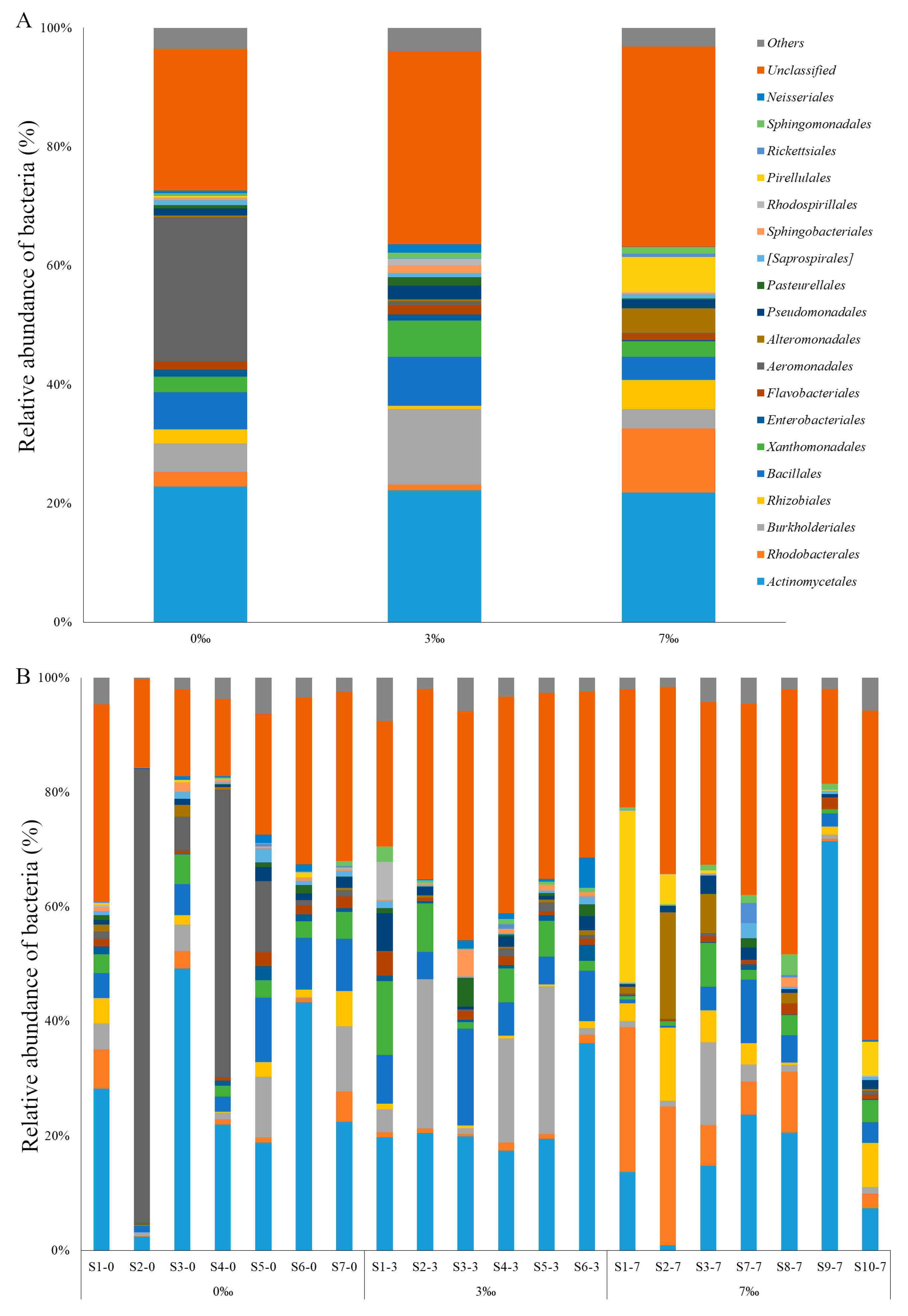
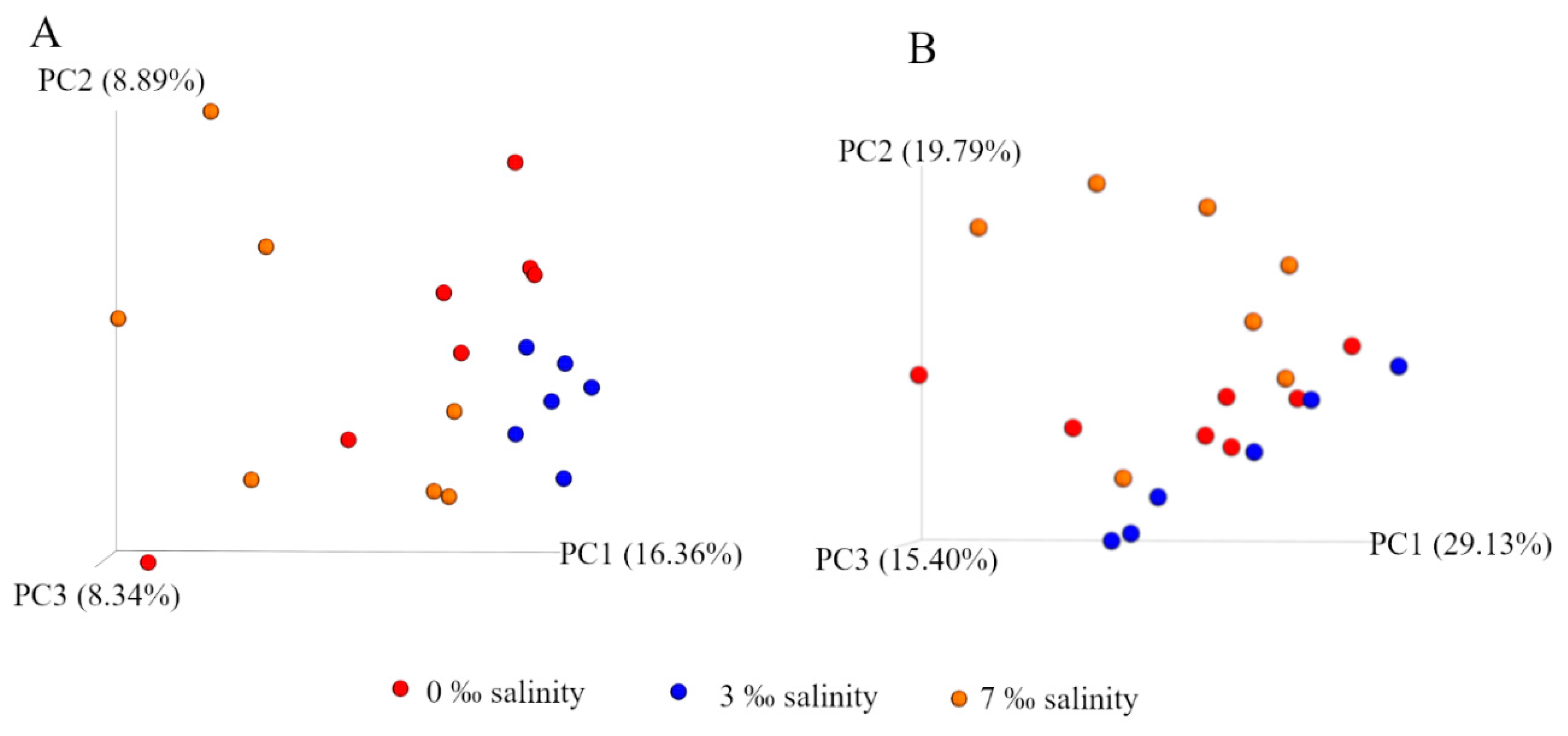
| Group/Tank Salinity | Number of Analyzed Fish | Reads | Observed Species | Shannon | Good’s Coverage | Chao1 |
|---|---|---|---|---|---|---|
| TS_0‰ | 7 | 9278 ± 5067 | 172 ± 34 | 5.1 ± 1.9 | 0.99 ± 0.0 | 174.3 ± 34.0 |
| TS_3‰ | 6 | 12,111 ± 3021 | 196 ± 23 | 5.9 ± 0.6 | 0.99 ± 0.0 | 197.3 ± 23.7 |
| TS_7‰ | 7 | 11,161 ± 2307 | 140 ± 39 | 5 ± 0.9 | 0.99 ± 0.0 | 141.9 ± 41.0 |
| Total number of reads taxonomically classified | 207,197 | |||||
| Mean number of reads per sample | 10,360 | |||||
| Total number of OTUs | 937 | |||||
| PERMANOVA Analysis | Unweighted Unifrac | Weighted Unifrac | ||
|---|---|---|---|---|
| p-Value | Pseudo-F | p-Value | Pseudo-F | |
| One-way | ||||
| All groups | 0.001 | 1.63 | 0.052 | 1.69 |
| PERMANOVA pairwise test: | ||||
| 0‰ vs. 3‰ | 0.002 | 0.241 | ||
| 0‰ vs. 7‰ | 0.137 | 0.146 | ||
| 3‰ vs. 7‰ | 0.001 | 0.031 | ||
© 2020 by the authors. Licensee MDPI, Basel, Switzerland. This article is an open access article distributed under the terms and conditions of the Creative Commons Attribution (CC BY) license (http://creativecommons.org/licenses/by/4.0/).
Share and Cite
Dulski, T.; Kujawa, R.; Godzieba, M.; Ciesielski, S. Effect of Salinity on the Gut Microbiome of Pike Fry (Esox lucius). Appl. Sci. 2020, 10, 2506. https://doi.org/10.3390/app10072506
Dulski T, Kujawa R, Godzieba M, Ciesielski S. Effect of Salinity on the Gut Microbiome of Pike Fry (Esox lucius). Applied Sciences. 2020; 10(7):2506. https://doi.org/10.3390/app10072506
Chicago/Turabian StyleDulski, Tomasz, Roman Kujawa, Martyna Godzieba, and Slawomir Ciesielski. 2020. "Effect of Salinity on the Gut Microbiome of Pike Fry (Esox lucius)" Applied Sciences 10, no. 7: 2506. https://doi.org/10.3390/app10072506
APA StyleDulski, T., Kujawa, R., Godzieba, M., & Ciesielski, S. (2020). Effect of Salinity on the Gut Microbiome of Pike Fry (Esox lucius). Applied Sciences, 10(7), 2506. https://doi.org/10.3390/app10072506






